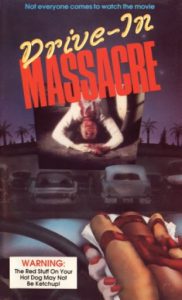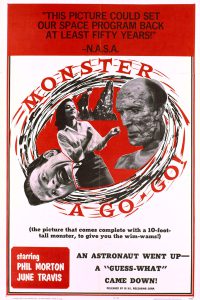The first time I saw Drive in Massacre (1976), I hated it. I had seen the VHS box on the shelves of my local video store, and it had been calling to me to rent it for quite some time. I loved slasher films, and I loved old fashioned gore films (hello Herschell Gordon Lewis), so this film seemed likely to be something that I might enjoy. However…
It was very short, according to the running time on the box, which may have been one reason that I hesitated and passed it over a few times. I’ve always liked to feel like I’m getting a good deal. A two hour movie would cost the same to rent as a 90 minute movie. Same with a three hour movie, or a two movie set (which was rare, but it happened occasionally). Drive in Massacre was only 78 minutes (it was actually less than that, but I can’t remember how much less). Why would I pay the same amount of money to rent a 78 minute movie when I could have so much more?
The answer eventually became “because I want to see this one.” So, one night, when it was late and I was tired, I decided that a 78 minute movie might be just about right.
 I say that it was actually less than 78 minutes. That’s because 78 minutes is the running time of the uncut version of Drive in Massacre. The VHS tape that I rented turned out to be a censored version of the movie. There was no gore whatsoever. And if you’ve ever seen Drive in Massacre, you know that aside from the gore there isn’t too much to recommend it. At least not to a young, unsophisticated viewer who has yet to develop a taste for the truly trashtastic limits of Not Quite Classic Cinema.
I say that it was actually less than 78 minutes. That’s because 78 minutes is the running time of the uncut version of Drive in Massacre. The VHS tape that I rented turned out to be a censored version of the movie. There was no gore whatsoever. And if you’ve ever seen Drive in Massacre, you know that aside from the gore there isn’t too much to recommend it. At least not to a young, unsophisticated viewer who has yet to develop a taste for the truly trashtastic limits of Not Quite Classic Cinema.
All I can recall about that edited cut of Drive in Massacre is that is was boring. Nothing happened (on screen). And it was ridiculously short, which offended me on principle in those days, but in this case might have been a welcome mercy. I was so angry that I had wasted $1.99 and my time on this movie that I actually wrote a message on the back on the box before returning it to the store: “Very bad – don’t rent,” or something very close to that. This was the only time that I ever dared to do something like that. I’m not sure if the store ever noticed, or tried to erase it, but they never asked me about it. Maybe they knew that tape deserved it.
Some years later, I bought a cheapo DVD set called Drive-In Classics, and was intrigued (and perhaps a bit disturbed) to see that Drive in Massacre was included in the set. I watched it, prepared to be just as bored and annoyed as the first time, but was pleasantly surprised to see that this copy of the movie contained some pretty over-the-top gore. And perhaps for this reason – or perhaps because my expectations had simply been lowered so far that nothing could have been bad enough to meet them – I found the movie much more enjoyable the second time.
Fast forward a lot of years, and I decided that I had to revisit this movie of dubious quality and decide once and for all if Drive in Massacre is a horrible waste of time, or a rare gem of cinematic wonder.

Two cops in Blood Feast (1963)
The first thing that struck me about Drive in Massacre is that it bears some resemblance to the films of Herschell Gordon Lewis. Nowhere near as good, of course, but I had to wonder if the filmmakers had perhaps been going for that. Just like in H.G.L.’s Blood Feast (1963), there are a series of gory murders, and two male cops investigate. And by investigate, I mean they do a lot of talking – to each other. This is something that always amused me about Blood Feast. We see a murder, and then we see two cops sitting around the police station talking about it. I’m sure it was due to budgetary concerns, but I always wondered why they didn’t get out there and DO something.

Are these two cops played by the same actor?!

Unbelievably, these actors are not even related.
The cops in Drive in Massacre are played by John F. Goff and Bruce Kimball and I swear to the Godfather of Gore that they look exactly alike! I thought for a minute that they were being played by the same actor! They are both overweight, dark haired, and they could be brothers. If they weren’t together in the same shot, I couldn’t tell which one was which. Hell, I couldn’t tell them apart when they WERE in the same shot. I’m not sure what kind of casting genius was at work here – maybe they both auditioned for the part of the cop, and the director couldn’t decide which one he liked better, so he cast them both. I think more likely they were the biggest names that the producers could convince to be in the movie, so they went with them even though they look a bit too much alike (a bit?!).
My friend Séan and I talked about this kind of casting phenomenon in our discussion of Canadian horror film Rituals (1977). To apply our thoughts to this movie, why not cast one cop with dark hair and one with blond or grey hair? Or one fat cop and one thin cop? Or one tall cop and one short cop? Or one man and one woman? There are endless possibilities that could have made these two characters easier to tell apart.
Having said this, as a connoisseur of the finer things in life (like Not Quite Classic Cinema), I actually LIKED the fact that Drive in Massacre made this strange casting choice. It added to my enjoyment of the movie.
The director, Stu Segall, had a long career in Hollywood. He made a few bad movies – I mean, Not Quite Classic Cinema classics, like Saddle Tramp Women (1972) — which is featured in Drive in Massacre, by the way. Other titles include Harvey Swings (1970), The Suckers (1972), and C.B. Hustlers (1976). He also made some golden age adult movies like Teenage Sex Therapy (1976), Spirit of Seventy Sex (1976), Teeny Buns (1978) and the X-rated classic Insatiable (1980), starring Marilyn Chambers.
As a director, Segall did more porn than non-porn, to be honest. But starting in about the mid-1980s, he produced a whole bunch of respectable TV shows and movies – starting with the classic Hunter (1984-1988). Other shows include Silk Stalkings (1991-1999), Pensacola: Wings of Gold (1997-2000), and 18 Wheels of Justice (2000-2001). His last credit was a show that only lasted for 4 episodes called Saints & Sinners in 2007. What an amazing career!
Drive in Massacre (1976) is #NotQuiteClassicCinema for those with an appreciation for Herschell Gordon Lewis, and a tolerance for sub-par imitations of Herschell Gordon Lewis. At only 78 minutes, with its gore scenes intact, it’s pretty easy to sit through. Without the gore scenes, it might be a bit of an endurance test. But if, like me, you take pleasure from campy details like two cops who look suspiciously alike, then you will find yourself amused throughout the movie. And let’s face it, any movie called Drive in Massacre will always be a welcome sight on a #FridayNightAtTheHomeDriveIn.
 Monster a Go-Go (1965) by #BillRebane
Monster a Go-Go (1965) by #BillRebane



